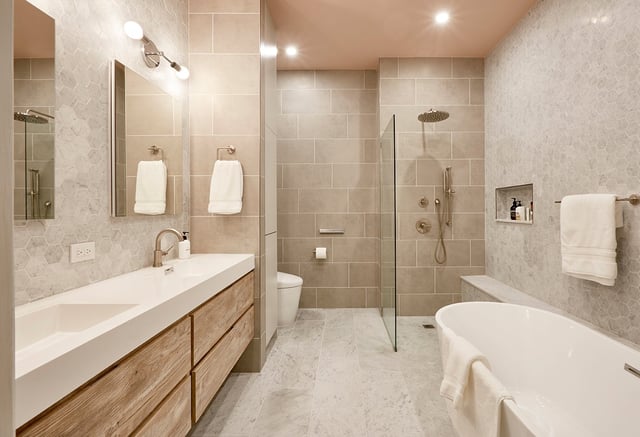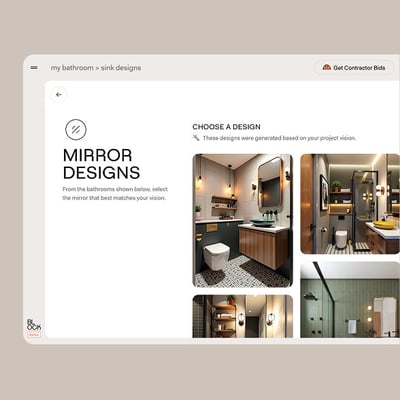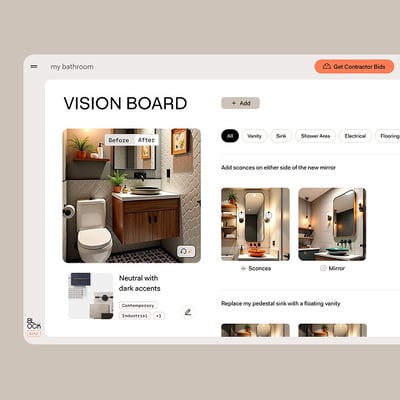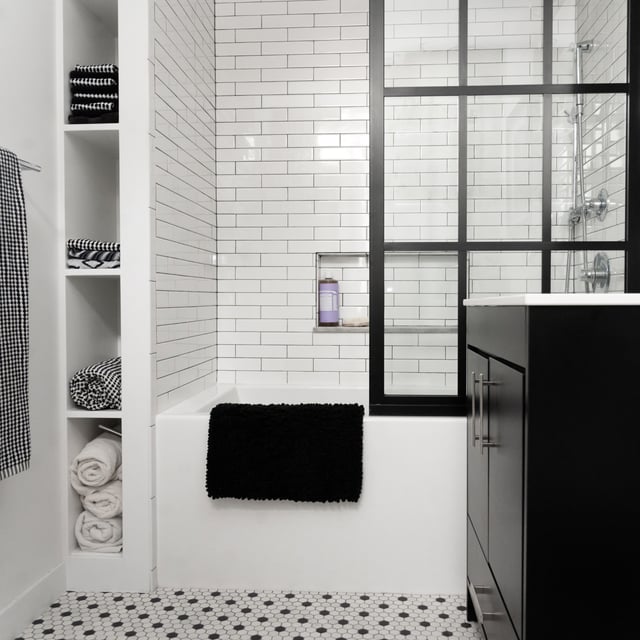
Remodeling
How to Choose Materials for Your Bathroom Remodel
04.23.2025

In This Article
Remodeling a bathroom? Congrats—you’re about to make more decisions than a contestant on a game show with a million doors. Tile or stone? Matte or glossy? Quartz or “whatever doesn’t stain when my kid drops toothpaste again”? Choosing materials for your bathroom remodel can feel overwhelming, but it doesn’t have to be. With a little planning (and maybe a Pinterest board or two), you can turn your space into the spa-like retreat—or durable family splash zone—of your dreams. This guide will help you make smart, stylish choices so you won’t be second-guessing your grout at 2 a.m.
When it comes to remodeling your bathroom, the materials you choose aren’t just about what looks pretty on a Pinterest mood board—they’re the unsung heroes (or villains) of your daily routine. Choose right, and you’ll have a bathroom that stands the test of time. Choose wrong, and, well… let’s just say peeling wallpaper and cracked tiles don’t exactly scream “spa retreat.”
Bathrooms take a beating. Hot showers, steamy mirrors, toothpaste-flinging toddlers—it’s a war zone. Materials like porcelain, quartz, and ceramic are tough cookies that can handle the humidity without losing their cool. Meanwhile, certain woods or porous stones may need more TLC than you have time (or patience) for. Durable materials save you from constantly scrubbing grout or battling mold colonies that form faster than you can say “squeegee.”
Sure, you could slap on basic white tiles and call it a day—but where’s the fun in that? The materials you choose set the tone for your entire bathroom vibe. Sleek marble gives hotel luxury. Matte black fixtures? Modern drama. Terrazzo floors? Hello, cool kid. Mixing and matching textures and finishes can take your bathroom from basic to boutique with just a few smart choices.
Here’s the thing: even if you’re not planning to sell tomorrow, future-you will thank present-you for choosing quality materials. Buyers notice when corners are cut (and not just literally). Good material choices look better longer and hold value—meaning you might just recoup more of that remodel budget when it’s time to move on. Think of it as investing in your morning routine and your future real estate listing.
Know the Cost Before You Start

Picking materials for your bathroom remodel isn’t just about what looks good under fancy lighting. It’s about making smart choices that won’t have you regretting every splash, scrub, or Sunday cleaning session. Before you fill your cart with marble and dreams, here are some key things to think about.
Let’s be real: bathrooms aren’t cheap. But that doesn’t mean you have to remortgage your house to get one that feels fresh. Look for materials that give you the best bang for your buck—like ceramic tiles that look like stone or engineered quartz that mimics marble without the “oops, I chipped it again” drama.
Bathrooms are wet. Like, really wet. So unless you enjoy moldy surprises or warping wood, moisture resistance is key. Go for materials that can handle humidity like a champ—porcelain, glazed tiles, and sealed stones are all solid choices. Literally.
If your dream bathroom includes weekly grout scrubbing… we can’t relate. Most of us want to clean less, not more. Choose materials that wipe down easily, resist stains, and don’t require a chemistry degree to maintain. Low maintenance = high happiness.
Thinking green? Good for you. Look for sustainably sourced wood, recycled materials, or low-VOC finishes. Your bathroom can be beautiful and kind to the planet—because even your shower tiles can make a statement.
Sure, you want your bathroom to stand out—but not like a spaceship in a farmhouse. Choose materials that flow with the rest of your home’s style so it feels intentional, not like you wandered into someone else’s Pinterest board. Consistency is classy.
The main job of flooring in a bathroom is to not betray you. It needs to handle water, humidity, and the occasional shampoo bottle drop without flinching. So before you fall for something that looks good but behaves badly, let’s talk about the best (and worst) flooring materials for your bathroom.
The classics. These tiles are basically the golden retrievers of bathroom flooring—reliable, good-looking, and easy to clean. Porcelain is denser and less porous than ceramic, making it more water-resistant, but both are great choices. Bonus: There are so many styles now, and you can make them look like wood, stone, or something straight out of a design magazine.
If you want to bring a little drama and luxury into your morning routine, natural stone is your friend. Marble screams elegance. Slate brings the moody spa vibes. Granite says, “I’m fancy but still practical.” Just remember: these need sealing and more maintenance, so they’re a bit more high-maintenance than tile. Worth it? Depends how into grout sealing you are.
Don’t knock it till you walk on it. Today’s waterproof vinyl and laminate options are stylish, surprisingly durable, and much more forgiving on your feet (and budget). Perfect if you want that wood look without worrying about water damage every time someone forgets to close the shower curtain.
Carpet. Just no. Wood? Risky unless it's engineered and properly sealed. And anything slippery when wet (hello, polished stone) is a lawsuit waiting to happen. If you’re going to dance in your towel, make sure your floor won’t send you flying. Choose wisely—your feet (and tailbone) will thank you.
Perfect Every Detail of Your Bathroom

Choosing wall and shower tiles isn’t just about picking the prettiest pattern—it’s about finding the perfect mix of style, practicality, and “will this still look good when I’m over my current design phase?” Here’s the breakdown of the best materials to keep your bathroom looking fresh (and not like a sad motel shower).
Subway tile is the little black dress of the bathroom world. It goes with everything, looks effortlessly cool, and never goes out of style. It’s budget-friendly and easy to clean, and you can mix it up with different patterns—think herringbone or vertical stacking if you’re feeling wild. Bonus: it won’t make your future self cringe.
Mosaics are like jewelry for your bathroom—best used to add sparkle, not cover the entire room. Think niches, shower floors, or a small accent wall. They come in glass, stone, ceramic, or even metal, letting you get creative without going overboard. Just beware: all those tiny tiles mean more grout lines and more grout lines mean more cleaning. Proceed with flair and caution.
Want a sleek, seamless look? Large-format tiles are your new best friend. Fewer grout lines = less cleaning and a more open feel. They’re perfect for modern, spa-like bathrooms where you want to pretend you're in a high-end resort—even if you're just rinsing off a toddler’s spaghetti disaster.
Grout: the unsung hero—or sneaky villain—of your bathroom. Choose a color that hides dirt (off-white, gray, or even bold black), and always seal it. Otherwise, your chic tile job will end up looking like a science experiment. Keep it cute, keep it sealed.
Learn More: How Much Does it Cost to Tile a Bathroom?
Countertops are where all the bathroom action happens—makeup, shaving, dramatic sighs into the mirror. So it’s worth picking a material that can handle the chaos while still looking fabulous. Here’s how to choose one that fits your budget, your style, and your tendency to knock over mouthwash bottles.
The holy trinity of countertop materials. Quartz is the low-maintenance overachiever—it’s non-porous, stain-resistant, and comes in a ton of colors and patterns. Granite brings the natural stone vibes and is super durable, but it does need sealing now and then. Marble? She’s a beauty, but she’s high-maintenance. Think: elegant but prone to drama (stains, etching, the works). If you’re the type who wipes up spills immediately, marble might be your moment.
Don’t sleep on laminate—it’s come a long way since your grandma’s 1980s bathroom. Modern laminate can mimic stone, wood, and other luxe materials for a fraction of the price. It’s lightweight, easy to install, and won’t make your wallet cry. Just keep in mind it’s not as heat- or scratch-resistant, so treat it with a little extra kindness.
Want a sleek, seamless look? Consider an integrated sink—where the sink and countertop are one continuous piece. It’s modern, easy to clean (no grime lurking around the edges), and great for low-fuss households. Just be sure the material you choose plays well with this design—solid surfaces like quartz or Corian are ideal, while natural stone might require more custom work. Either way, fewer crevices = fewer weird soap blobs.
Cabinets and vanities may not get as much design hype as tile or countertops, but they do a lot of heavy lifting—literally. They hold your hairdryer, your backup toothpaste stash, and probably at least three mystery products you forgot you bought. So, picking the right material matters more than you think.
Solid wood sounds fancy—and it is! It’s strong, durable, and gorgeous but can warp in humid bathrooms if not properly sealed. Plywood is the practical middle child: stable, water-resistant-ish, and budget-friendly. MDF (medium-density fiberboard) is the least expensive of the bunch and gives you a smooth finish for painting, but it does not like water. Like, at all. So keep it well protected unless you want it puffing up like a croissant.
No matter what cabinet material you choose, make sure it’s dressed for the moisture party. That means waterproof finishes, high-quality paint or laminate coatings, and proper sealing around edges and seams. Pro tip: avoid putting your vanity directly under a ventless shower unless you enjoy peeling finishes and future regrets.
Want to go green in the bathroom? Good for you (and the planet). Look for FSC-certified wood, recycled materials, or bamboo—nature’s overachiever. Low-VOC finishes, and formaldehyde-free MDF is also smart picks if you want to keep things healthy at home. Bonus: eco-friendly options are often just as stylish, so you can save the earth and still have a Pinterest-worthy powder room. Now that’s a win-win.
You might think faucets and drawer pulls are bathroom afterthoughts, but oh no—these little details are the jewelry of your space. The right hardware can make your vanity look like a million bucks (even if it was definitely on sale), and the wrong one… well, let’s just say even the prettiest tile can’t distract from a rusty towel bar.
Bathrooms = water. Water = rust. So, choose rust-resistant materials unless you want your hardware to age like a sad shipwreck. Brass brings a warm, timeless glow. Stainless steel is sleek and modern. And powder-coated options (like matte black) hold up surprisingly well if you’re not bathing them in steam 24/7. Bottom line: skip anything that looks cute but won’t survive your post-shower fog zone.
Matchy-matchy or mix-it-up? Either works—just make it intentional. A matte black faucet with matching drawer pulls feels modern and bold. Brushed nickel gives off that soft, spa-like shine without the glare. Gold tones add a little glam. Choose a finish that complements your tile and countertop, not competes with them. You’re going for coordinated, not chaotic.
Yes, you can mix finishes—but it takes a little finesse. Think of it like accessorizing: your earrings and necklace don’t have to match exactly, but they should look like they’re going to the same event. Try anchoring one dominant finish and adding one contrasting accent. For example: brass fixtures with matte black cabinet hardware? Chic. Chrome everything with a random copper hook? Maybe not. Choose with purpose—and a little personality.
Bring Your Dream Bathroom to Life

So you’ve picked your tile, countertop, and cabinet finish… and suddenly, your bathroom feels like it’s wearing five different outfits at once. Don’t panic. Pulling everything together is all about a few smart moves—and resisting the urge to buy that sixth type of tile just because it’s “fun.”
Before you commit, gather samples of everything—tile, countertop, paint swatches, cabinet finishes, even hardware. Lay them all out together like a little flat-lay mood board. If something looks out of place now, it’s definitely going to look out of place when it’s glued to your wall. Plus, it’s way cheaper to swap a sample than redo your entire shower niche.
You don’t have to hire a designer, but it’s kind of like having a bathroom fairy godparent. They’ll help you avoid layout disasters and gently steer you away from pairing marble with, say, seashell-shaped pink sinks (unless that’s your thing, in which case—bold choice). A good contractor is equally clutch—they’ll know what materials actually work together and how to install them so they stay looking sharp.
We get it—TikTok made you want a sage green vanity, gold fixtures, and checkerboard floors. But trends fade, and bathrooms are expensive to redo every five years. Instead, pick one or two trend-forward details and keep the rest classic. That way, when avocado tile makes a comeback (again), you won’t be stuck wondering what you were thinking. Your bathroom should feel like you, not like an algorithm designed it.
Learn More: The Ultimate Guide a Designing a Modern Bathroom in 2025
At the end of the (tile-lined) day, your bathroom remodel is only as good as the materials you choose. Remember: your north stars should be durable, moisture-resistant, and easy to clean. Bonus points if they also look amazing on Instagram. Don’t get seduced by trends that won’t last or finishes that can’t handle your steamy morning routine.
Prioritize function, longevity, and a little personality—because your grout color says something about you. Choose wisely, and your bathroom will be the serene, splash-proof sanctuary you deserve—no moldy regrets or mid-shower breakdowns required.
What are the most durable materials for a bathroom remodel?
Interested in learning more?
How do I choose the best tiles for my bathroom walls and floors?
What materials should be avoided in a bathroom renovation?
Are natural stone materials a good choice for bathrooms?
What’s the most cost-effective material for bathroom countertops?

Calculate the true cost of your bathroom remodel
Get real-time cost estimates for materials and labor, so you can budget your renovation with confidence—no guesswork.

Remodeling
How to Choose Materials for Your Bathroom Remodel
04.23.2025

Finance
How to Finance your Bathroom Remodel in Chicago
04.15.2025

Design
What is a Frameless Glass Shower Screen?
03.25.2025

Finance
Ultimate Guide to Chicago Bathroom Financing
03.24.2025

Remodeling
How to Finance a Bathroom Remodel in New Jersey
03.19.2025
Renovate confidently